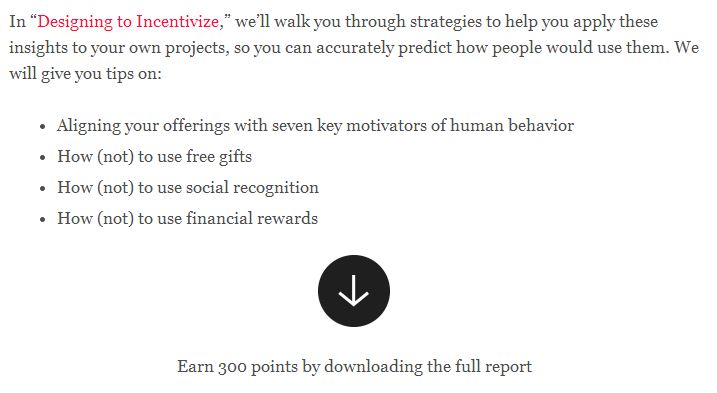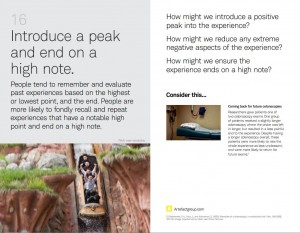Back in 2012 I posted about different card decks I’ve seen and used while facilitating (mostly face to face.) It turned out to be a popular post, so when I see new decks (like with then FABULOUS Groupworks Deck came out) I blog about them. Today one of the folks from the Open Innovators group at the Hague University (where I have fun facilitating in the autumn) posted about a deck I hadn’t seen on facilitating behavior change and I thought I’d add this one to the evolving list. (Update: Here is another great list.)
The behavior change cards come from the Artefact Group. (Hey, they are in Seattle!) Here is their blurb:
This set of 23 cards was crafted to help designers, researchers, and anyone facing a behavior change challenge, think through strategies to nudge people toward positive behavioral outcomes. They work particularly well when you have in mind a specific behavior that you want to change (e.g., “We want to get more people to ride the bus,” or, “We want people to stop smoking”). We focused on making these strategies easy to grasp, incorporate, and act on.
The set is divided into five thematic sections, each featuring strategies and examples that will help you understand whythe strategies are effective, and prompt you to think through how they might be used.
- Make it personal: The persuasive power of “me” and “my” (cards 1– 6)
- Tip the scales: How perceptions of losses and gains influence our choices (cards 7– 13)
- Craft the journey: Why the entire experience matters (cards 14 – 17)
- Set up the options: Setting the stage for the desired decision (cards 18 – 21)
- Keep it simple: Avoiding undesirable outcomes (cards 22 – 23)
These cards should be considered a starting point, to help you think through strategies and brainstorm new ideas you may not have previously considered. Keep in mind that any given strategy, on its own, is unlikely to be a silver bullet. And while some of these strategies may work in the short term, they don’t necessarily guarantee long-term success. At the end of the day, the only way to make sure that what you’re designing has the outcome you desire is to test it with real people.
From a quick glance the cards have a product design perspective, which makes sense as the Artefact Group works in design. I scrolled through them to consider how they might work the international development contexts I often find myself. The images feel pretty North American to me, and reflect a strong consumer culture. I could see using the cards in the US even outside of commercial product design because the examples are familiar and would offer good thinking triggers. In international development the consumer emphasis and images would not translate well. The tips and ideas are useful and I think they would resonate in other cultures with appropriate reframing for different contexts.
A little side note: As an American, I have to be particularly sensitive as people often default to a “disregard that – just another American thing” when I bring them, even if the thing I bring is NOT American. Our cultural identities and our perceptions are strong! My behavior is deeply connected to my roots, so the act of carrying ideas across boundaries is essential to my work, but it has to be done with quite a bit of care. And I still mess up!
This is one of the really tough things with any of these decks is how to make them useful across domains and cultures. Wouldn’t it be nice to be able to take a deck and remix the images? Tweak the text and create a remixed deck altogether? Someone clever could program that, I’m sure.
In the meantime, the resonance of all the decks I’ve tried is the mix of the visual with the images, the tactile experience of the cards (moving them around, sharing them in a group setting, etc.) and the triggers that both the images and the words offer us to step, at least slightly, out of our practiced thinking and behaving pathways. (Yeah, ruts!)
While you are on the Artefact Group’s site, check out their larger set of resources. I was drawn a couple of other toolkit elements with a strong visual focus. Check out Designing for Empathy and their relationship map (see also their whitepaper which is actually YELLOW!) . I have also downloaded “Designing to Incentivize” but haven’t read it yet. (And yes, I still dislike the word “incentivize” but I’m very interested in when incentives help and when they screw things up!) Clearly these folks have a good sense of humor. Here is a screen shot of the page with the summary of the incentives piece:

Ha, here is a deck for kids on emotional intelligence… https://www.youtube.com/watch?v=LfXsjrzu3i8 I can see an adult version !
My first experience using cards in group experiences was long ago, in the early nineties. The facilitator always bought a lot of postcards whenever he visited an art museum, buying a wide range of art on those postcards.
He used those postcards in endlessly different ways.
For years, I bought tons of postcards at art museums and used those postcards. Then with my household goods in storage in a friend’s basement, a pipe broke and most things ruined.
I miss those cards. They worked better, at least for me, than any created cards. Think of the range of images created by artists and the endless variety of those visual images put on postcards. The facilitator has to be creative, to think, to turn art post cards into group games and lessons but this is still my favorite card game: art postcards.
Alas, I have no postcard collection now.
I should dig around, Tree. I think I have a box of postcards. I was saving them for years for a penpal. Then we both grew up! 🙂
Hi Nancy,
Thanks for sharing. This post and even more so for pointing to the older, longer one, with all these different cards I am now digging into. As you know I have just started drafting “Network Flashcards”, to help teams identify and work with difficult stakeholder situations and I am facing one problem you mention in your post too: Culture. I want to make them approacheable for the developing world partners I am working with. But I also see the same patterns in developed countries, so they would be useful here too.
But the suspicion goes both ways: If I add an African picture or example, people in the US would think: Oh, this is just for these poor, underdeveloped people. So I might end up doing two sets – because without concrete examples and pictures, or with examples and pictures that are so culturally sanitized that they loose meaning, the cards would loose a lot of their power…
Interesting – we had this very conversation about the Liberating Structures evolving deck. I mentioned to Keith McCandless that I felt there were some cultural bridging opportunities, and that his co-creator Henri felt things should stand alone. It might be good to rope them into a conversation.
Another lens on this is that today I was with a bunch of test engineers at a software company and it is interesting that while the business drivers are very different, the process and practice issues had incredible resonance to development work. So maybe it is a small world after all!
Hi Nancy,
Yes, agree totally with your second point, that the issues (especially when looking at what network structures are dysfunctional and functional) are so similar in developing and developed countries. But there is definitely a crowd that we alienate if we say that. And this goes beyond the difference in the extremes. The more I am exposed to mid-income countries (e.g. in Asia) the more I realize that bringing examples from lower income countries will make them feel like: This has nothing to do with us. It’s like everyone is looking for someone weaker against which they can look strong…
I’d love to hear what the liberating structures people are saying about this.